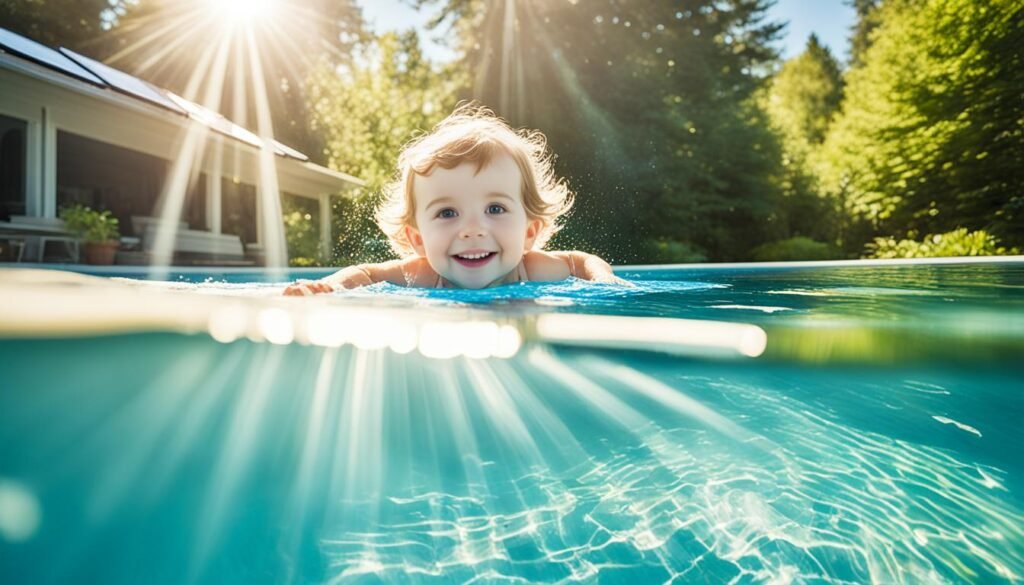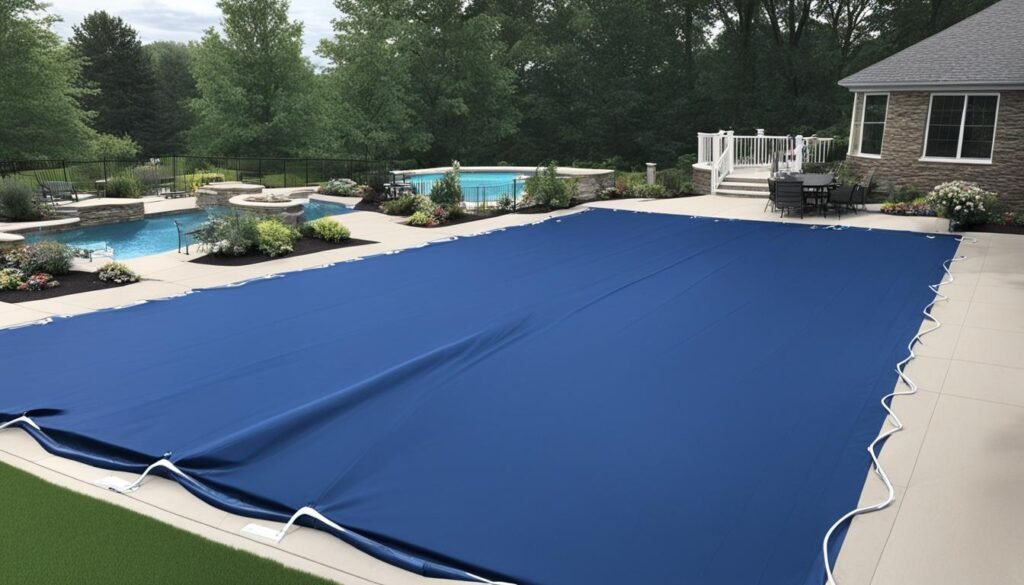For pool owners seeking to improve their pool’s efficiency and longevity, the use of a solar cover is an unrivaled solution. Its role in solar cover for pool longevity is well-documented, serving as a shield against heat loss and evaporation. Yet many wonder about the benefits of leaving solar cover on around the clock and whether this practice aligns with pool cover best practices. In essence, keeping the cover on can be a game-changer, provided it’s done in accordance with certain guidelines to ensure safety and optimize benefits.
One of the primary advantages of a solar cover is its ability to maintain warmer water temperatures, a benefit that extends even as the sun sets. Ideally, the cover should remain in place to maximize heat retention, particularly during off-use periods and cooler nights. Nevertheless, special attention must be given during severe weather, or when chemical treatments are applied to the pool, as these situations may require temporary removal to preserve the cover’s integrity.
Consistent application of a solar cover contributes to a healthier pool environment, not only through improved temperature control but also by reducing water loss and chemical consumption. The decision to use a solar cover 24/7 is nuanced, resting on factors including climate, pool usage, and routine maintenance activities. When in doubt, referring to established pool cover best practices can steer pool owners towards decisions that prolong the life of the cover while enhancing pool enjoyment.
Key Takeaways
- Continuous solar cover use can provide significant protection against temperature loss.
- Leaving the cover on may lead to substantial water and chemical savings, optimizing pool operations.
- Proper adherence to pool cover best practices ensures both the safety of the cover and pool efficiency.
- Temporary cover removal is necessary following pool treatments or during adverse weather conditions.
- Maintaining the cover according to manufacturer guidelines will extend its lifespan and effectiveness.
- The full potential of solar covers is unlocked through consistent and informed daily use.
Understanding Solar Covers and Their Design
In the quest for maximizing solar cover efficiency, a deep understanding of their design is quintessential. Originating from a serendipitous discovery in the 1960s, solar covers have evolved into sophisticated components of pool maintenance. By integrating proper use of pool covers, pool owners are able to reduce running costs and extend the lifespan of their swimming pools.
The Science Behind Solar Cover Efficacy
The performance of solar covers is driven by the science of heat retention. An air-filled bubble design, forged from UV-stabilized polyethylene or polypropylene, captures solar energy, significantly slashing evaporation heat loss. Consequently, pools swathed in a solar blanket can enjoy a whopping 95% drop in evaporative heat loss, contributing to a temperature upsurge that greatly enhances pool usage during cooler periods.
Comparing Solar Cover Types: Thickness, Color, and Material
Extending pool cover lifespan involves choosing the appropriate solar cover, which comes in various thicknesses and colors. These covers are gauged by their ‘mil’ rating, affecting both durability and price. A 16 mil cover sits at the zenith, offering supreme resilience, while an 8 mil cover provides agility but demands more solar cover care tips to preserve its quality. Color choice, too, plays a pivotal role in heat absorption, with certain hues proving more proficient at warming your aqua oasis.
How Solar Covers Complement Your Pool’s Maintenance Routine
Following pool maintenance best practices, a solar cover proves to be more than just a barrier against the elements; it’s an ally in thermal regulation and chemical preservation. Correct implementation, which includes sizing and installation geared towards proper use of pool covers, not only maximizes solar cover efficiency but synergizes with existing pool maintenance schedules to ensure that your pool remains in prime condition throughout its seasonal and year-long usage.
Can I Leave a Solar Cover on All the Time?
When it comes to pool maintenance, homeowners often ask, “Can I leave a solar cover on all the time?” The simple answer is that while it is beneficial to have your solar cover in place when the pool is not in use, there are specific instances where it needs to be removed to maintain its integrity and the safety of the pool’s ecosystem. Understanding these instances can help extend the lifespan of your solar cover and ensure it provides the maximum benefits of leaving a solar cover on your pool.

| Condition | Action Required | Reason |
|---|---|---|
| Severe Weather | Remove solar cover | To prevent damage from extreme elements like wind or hail |
| Chemical Treatment | Remove and wait for chemical balance | High chlorine levels post shocking can degrade cover material |
| Imbalanced Water Chemistry | Correct imbalances before replacing cover | Acidic or alkaline waters can deteriorate the solar cover |
While leaving the solar cover on can reduce evaporation and retain heat, it should not be seen as a constant fixture atop your pool. Periodic assessment of the factors mentioned above should guide whether the cover remains in place. By heeding these precautions, the material of your solar cover remains safeguarded against premature wear, ensuring it can continue to contribute to a more energy-efficient and cost-effective pool environment.
Maximizing Solar Cover Efficiency with Proper Use and Maintenance
Consistently harnessing the full potential of your solar cover hinges on key solar cover care tips and fastidious maintenance practices. These strategies are designed to fortify solar cover efficiency, protract its serviceable life, and facilitate a superior swimming experience.
Best Practices for Daily Solar Cover Use
Integrating pool cover best practices into your daily routine can significantly enhance the functionality of a solar cover. Utilization of a solar cover reel, for instance, not only simplifies the process of covering and uncovering your pool but also mitigates the risk of damage that can occur when handling the cover manually. Below are actionable guidelines that can amplify solar cover for pool longevity:
- Deploy a cover reel to prevent wrinkles and wear.
- Trim the cover to fit your pool’s shape for optimal coverage without overhangs.
- Remove the cover with care before high-chlorine treatments to circumvent degradation.
Solar Cover Maintenance: Care Tips for Longevity
To extend the pool cover lifespan, committing to regular solar cover maintenance is paramount. Here’s a concentrated look at several maintenance measures:
- Clean the solar cover regularly using a gentle, non-abrasive cleaner to deter algae and dirt accumulation.
- Ensure the cover is completely dry before storage to prevent mold and mildew growth.
- Store the solar cover away from direct sunlight when not in use, as prolonged UV exposure can expedite the wear process.
The Balance Between Cover Use and Water Chemistry
Respecting the correlation between solar cover use and maintaining the correct water chemistry is a necessity for solar cover maintenance. A stable chemical balance in your pool helps in preserving the solar cover’s integrity. Adjust pH levels and chlorine content diligently to prevent the premature weathering of your solar cover, which could otherwise turn brittle or discolored.
Acknowledge the solar cover as a participant in your pool’s ecology. Harmonizing its use with the water’s chemistry ensures a beneficial outcome for all involved—your solar cover, your pool, and your peace of mind.

Conclusion
In assessing the benefits and best practices associated with solar covers, it’s clear that their proper use can indeed permit a pool to remain covered consistently. Utilizing a solar cover presents a wealth of advantages, not least the ability to significantly amplify pool temperature while diminishing routine maintenance expenses. With the application of **pool cover best practices**, this indispensable tool can provide substantial, long-term contributions to both the functionality and sustainability of a pool.
The query, “Can I leave a solar cover on all the time?”, often surfaces among pool owners. The answer, while generally affirmative, does require attention to specific circumstances to ensure the cover’s longevity. By adhering to maintenance guidelines—such as removal during extreme weather, after chemical treatments, and in balance with water chemistry—the solar cover can serve as a reliable, energy-saving asset round the clock in favorable conditions.
Ultimately, the diligent use and care of a solar cover represent an integral aspect of efficient pool management. For the pool owner dedicated to extracting maximum value from their investment, understanding the intricacies of solar cover deployment aligns with overarching goals for enhanced pool enjoyment, safety, and fiscal prudence. Thus, a well-maintained solar cover stands as more than just an accessory; it’s a testament to responsible pool stewardship.
FAQ
Can a solar cover be used 24/7 without harming my pool?
Yes, a solar cover can generally be left on your pool to enhance pool longevity and offer various benefits. It acts as a barrier to heat loss and evaporation, conserving water and maintaining the pool’s warmth. However, it should be removed during severe weather, after chemical treatments like shocking, or when the pool’s water chemistry is imbalanced to prevent damage to the cover.
What is the function of a solar cover, and how does it work?
A solar cover minimizes heat loss through evaporation, keeping your pool water warmer and reducing the consumption of water and pool chemicals. The cover contains air-filled bubbles that capture solar energy and transfer it to the water, making it an efficient way of maximizing solar heat gain and improving pool maintenance routines.
How do different types of solar covers vary in terms of efficiency?
Solar cover efficiency is influenced by thickness, color, and material. Covers with higher mil ratings are thicker, providing better heat retention and durability against UV rays and pool chemicals. Colors like clear or blue/black combinations are most effective at trapping heat, while the material composition can affect longevity and heat transfer properties.
Why should a solar cover be removed after adding pool chemicals or shocking the pool?
High levels of chlorine and other chemicals can be detrimental to the solar cover material. Removing the cover after chemical treatments allows the chemicals to dissipate and prevents the cover from sustaining damage, thereby extending its lifespan and maintaining its efficacy.
Are there any special considerations for using solar covers during different seasons or weather conditions?
In cooler seasons or during periods of non-use, it is beneficial to keep the solar cover on to retain heat. However, during high winds or storms, the cover should be removed to prevent damage. When stored during the off-season, the cover should be cleaned, dried, and stored away from extreme temperatures to avoid degradation.
What are the best practices for maintaining a solar cover?
To maximize the lifespan of a solar cover, it is essential to keep pool chemicals balanced, use a solar cover reel for easy handling, and avoid leaving the cover bunched up or exposed to the sun when not in use. Regular cleaning, careful handling, and proper storage are key practices for maintaining a solar cover.
How does water chemistry affect the longevity of a solar cover?
Maintaining the correct balance of pool water chemistry, especially chlorine levels, pH, and calcium hardness, is crucial to preventing the solar cover from becoming brittle or discolored. Imbalanced chemicals can cause the cover material to degrade faster, reducing its efficiency and lifespan.
What are the benefits of leaving the solar cover on the pool?
Leaving the solar cover on the pool when not in use can help retain the water’s heat, minimize evaporation, save on chemical usage, and keep debris out. This can lead to a warmer pool with lower maintenance costs and a reduced environmental impact.
